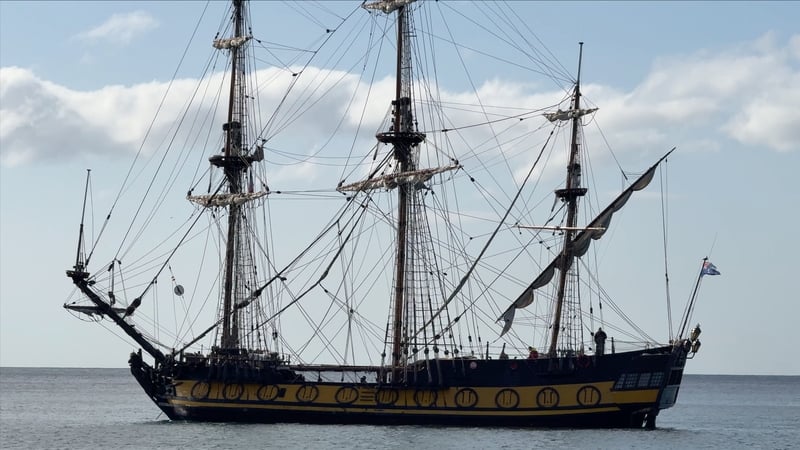

A contentious vessel, the Shtandart, a meticulously crafted replica of a ship commissioned by Russia’s Peter the Great in the early 18th century, has sparked considerable debate as it currently lies anchored off the scenic Irish coast in Killiney Bay. This modern-day replica, built in 1999 and operating under the flag of the Cook Islands, describes itself as an “active sail training ship.”
A Symbol of Imperial Russia Meets Modern-Day Geopolitics
The original Shtandart, launched in 1703, was a frigate instrumental in Peter the Great’s ambitions to establish Russia as a naval power. Its replica, an exact copy, aims to preserve maritime heritage and offer sail training experiences. However, its presence in European waters has become deeply entangled with the ongoing geopolitical fallout from Russia’s invasion of Ukraine.
Calls for Exclusion: “A Facade for a Bloody Regime”
For many, particularly those within the Ukrainian community, the Shtandart is not merely a historical replica but a symbol of a problematic regime. Ukrainian Action in Ireland, a charity actively supporting Ukrainians in the country, has vehemently protested the ship’s presence, urging Irish maritime authorities to “deny entry to Irish ports to the Shtandart.”
Anatoliy Prymakov of Ukrainian Action in Ireland articulated their stance clearly: “We don’t want that ship to be welcomed here. We want them to know that Ireland stands with Ukraine. We want them to know you can only parade your ship around Europe once Russia has ceased its war on Ukraine. The ship is a facade for a bloody regime.” This sentiment underscores the profound emotional and political weight the vessel carries for many.
The ship’s anchoring yesterday in Killiney Bay, directly in front of Dalkey’s prominent ÉIRE sign—one of over 80 built during World War II to indicate Ireland’s neutrality to pilots—has only amplified the visual irony and the public discourse surrounding its arrival.
The Captain’s Defense: “Fighting for Survival”
In response to the mounting criticism, Captain Vladimir Martus defended the Shtandart’s operations. Speaking to RTÉ News, Martus stated the ship was en route from St Malo, France, to Aberdeen, Scotland, carrying 22 individuals from 12 different nations. He dismissed the criticism as “unjust and unfair.”
“We are against what Putin is doing and nobody on this ship has ever expressed support for Russia,” Captain Martus asserted. He emphasized the vessel’s true purpose: “The Shtandart is simply a replica vessel. We are not a Russian vessel. Shtandart is, and always has been, dedicated to education, heritage, and human connection. We are a homeless child in European waters, and we are fighting for survival.” Martus indicated the vessel was expected to depart tomorrow afternoon but would require another stopover “somewhere.”
Navigating Regulations: Department of Transport’s Position
The Department of Transport has acknowledged its awareness of the Shtandart’s movements. In a statement to RTÉ News, the Department clarified that the vessel “has not entered a pre-arrival notice for entry into an Irish port which is required under EU regulations.” Furthermore, the statement highlighted that “through third party sources it is understood that the vessel is registered under the Russian flag and would likely fall under the restrictive measures.”
This suggests a potential conflict between the ship’s operational flag (Cook Islands) and its suspected registration, which could bring it under the purview of EU sanctions. The Department confirmed it has been in communication with ports under its remit on the east coast “to ensure appropriate measures are taken,” indicating a cautious and vigilant approach to the vessel’s presence in Irish waters.
The ongoing situation with the Shtandart serves as a poignant reminder of how historical objects and cultural endeavors can become inadvertently entangled in contemporary political conflicts, forcing nations and individuals to grapple with complex questions of symbolism, sanctions, and humanitarian concerns.
What do you think about the Department of Transport’s stance on the Shtandart’s registration and its potential implications under EU sanctions?



